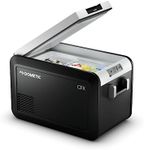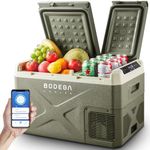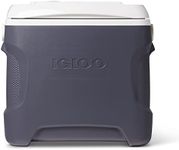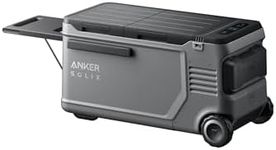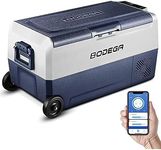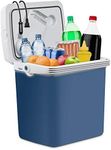Buying Guide for the Best Electric Cooler
Choosing the right electric cooler can make a big difference in how you store and transport food and drinks, whether you're camping, road-tripping, or just need extra cooling space. The best electric cooler for you depends on how you plan to use it, how much you need to store, and where you'll be plugging it in. Understanding the main features and how they relate to your needs will help you make a smart choice.CapacityCapacity refers to how much the cooler can hold, usually measured in liters or quarts. This is important because it determines how much food and drink you can store at once. Small coolers (under 25 liters) are great for solo trips or short outings, while medium sizes (25-40 liters) suit small families or groups. Large coolers (over 40 liters) are best for extended trips or bigger groups. Think about how many people you need to serve and how long you'll be away from a regular fridge to decide what size is right for you.
Power SourceElectric coolers can be powered by different sources, such as a car's 12V outlet, a standard wall plug (AC), or sometimes even batteries or solar panels. This matters because it affects where and how you can use the cooler. If you mostly travel by car, a 12V option is convenient. For use at home or in cabins, an AC plug is useful. Some models offer both, which adds flexibility. Consider where you'll use the cooler most often and make sure it matches your available power sources.
Cooling TechnologyThere are two main types of cooling technology: thermoelectric and compressor. Thermoelectric coolers are lighter, quieter, and usually less expensive, but they can only cool to a certain degree below the outside temperature, making them best for mild climates or short trips. Compressor coolers work like mini fridges, offering more powerful and consistent cooling, even in hot weather, and can sometimes even freeze items. If you need to keep things very cold or frozen, or if you'll be in hot environments, a compressor model is a better choice. For lighter needs or cooler climates, thermoelectric may be enough.
Temperature ControlSome electric coolers let you set a specific temperature, while others just have basic cooling or warming modes. Adjustable temperature control is important if you want to store sensitive items or need to switch between cooling and freezing. If you just need to keep drinks cold, simple controls may be fine. If you want more flexibility, look for a model with a digital display or adjustable thermostat.
PortabilityPortability covers the cooler's weight, handles, wheels, and overall ease of moving it around. This is important if you plan to carry the cooler over distances or lift it in and out of vehicles. Lightweight models with sturdy handles or wheels are easier to manage, especially when fully loaded. If you'll mostly keep the cooler in one place, portability may be less of a concern, but for travel and outdoor use, it's worth considering.
Energy EfficiencyEnergy efficiency refers to how much power the cooler uses to keep things cold. This matters if you'll be running the cooler off a car battery or limited power source, as more efficient models will drain less power and can run longer. Look for information on power consumption, usually listed in watts. If you need to run the cooler for long periods without recharging, choose a model known for low energy use.
Durability and Build QualityDurability is about how well the cooler can handle bumps, drops, and outdoor conditions. A sturdy build with quality materials means the cooler will last longer and protect your food and drinks better. If you plan to use the cooler outdoors or in rough conditions, look for models with reinforced corners, strong hinges, and weather-resistant features. For mostly indoor or gentle use, this may be less critical.
